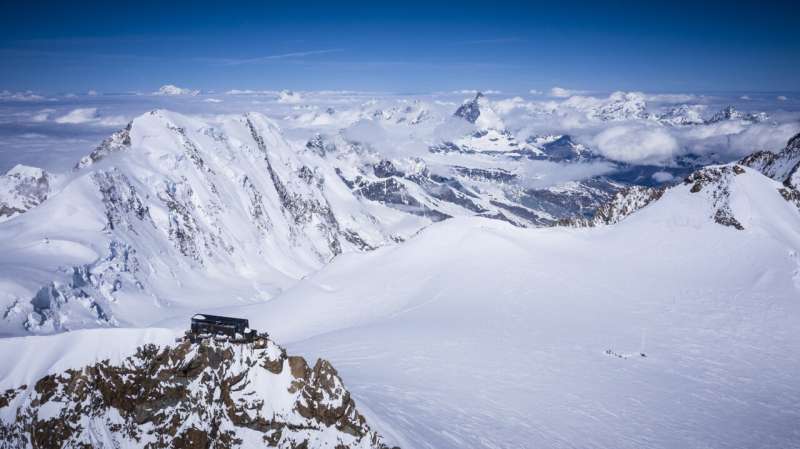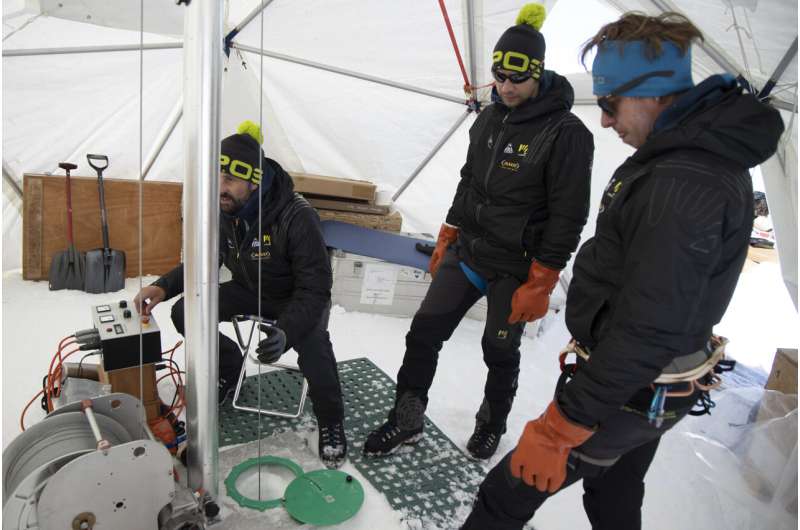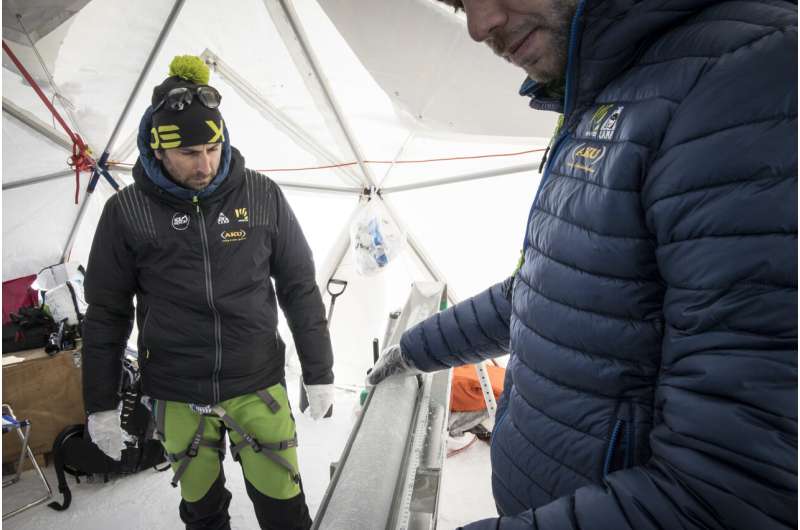The most ancient ice in the Alps will be preserved in Antarctica

The Ice Memory international mission on Monte Rosa has been accomplished. After working for five days at 4,500 meters in the accumulation zone of the Grenzgletscher, the glacier saddle of Colle Gnifetti, scientists extracted three shallow ice cores (15-22 meters) and two deep ice cores reaching down to bedrock at 82 meters depth.
In the section closest to the rock, these ice cores contain information on the climate and environment of ten thousand years ago, meaning that the most ancient ice in the Alps will be stored in Antarctica for decades and centuries to come.
The mission was organized by the Institute of Polar Sciences (ISP) of the Italian National Research Council, Ca' Foscari University of Venice, and the Swiss Paul Scherrer Institute.
Ice Memory is an international program that aims to provide, now and for decades and centuries to come, the raw material and data necessary for scientific advances and political decisions that contribute to the sustainability and well-being of humanity. It aims to do so by creating, in Antarctica, an archive of ice cores from the Earth's mountain glaciers currently in danger of degradation or disappearance.
"The mission was a success: the team obtained two ice cores over 80 meters deep from a very important site, which contains information on the climate of the last ten thousand years," says Carlo Barbante, director of the CNR-ISP and professor at Ca' Foscari. "The team worked well despite the harsh weather conditions, with strong gusts of wind and snow. Now this precious archive of the climate history of the Alps will be preserved for the future."
"For ice core research in the Alps, the Colle Gnifetti glacier saddle is iconic with the first ice core drilling expedition already in 1976, shortly after initiation of this research field in the 1960s in Greenland," emphasizes Margit Schwikowski, head of the Laboratory of Environmental Chemistry at Paul Scherrer Institut and professor at the University of Bern. "At that time it was speculated that the saddle consists of cold ice, without any melting, a prerequisite for a reliable preservation of the environmental information, which was shown to be correct. I am therefore extremely pleased that we succeeded in collecting cores from this site for the Ice Memory program".

"We are extremely happy and proud that we successfully accomplished this mission," adds Theo Jenk, a researcher at the Laboratory of Environmental Chemistry at Paul Scherrer Institut and leader of the expedition. "Considering the extreme location of sampling sites such as the one on Colle Gnifetti, the high altitude of more than 4,500 meters and the often harsh weather conditions, such success can never be guaranteed. In a strong, international collaborative team effort, we managed just that, and most importantly, all team members returned back safely. The Laboratory of Environmental Chemistry (LUC) from the Paul Scherrer Institut has a long tradition of several decades in studying the glacier archive at Colle Gnifetti. A site, which we showed to most likely contain the oldest ice in the Alps. Because of that, helping to secure an ice core from this site—providing access to an extremely valuable climate and environmental archive of past European history but now in danger of being lost forever due to the ongoing warming—is definitely a highlight for us as a group. We are very happy that thanks to our expertise in ice core drilling and high-altitude expeditions we were able to make a significant contribution to the Ice Memory project in this particular case."
"Ice Memory is one of Ca' Foscari's most significant projects," says Tiziana Lippiello, Rector of Ca' Foscari. "Our university was among the first to engage in the study of climate change and its impact on various areas (economics, science, society, culture). Our climate is in a state of emergency. In order to face this crisis, we need to understand the causes and find possible solutions, so research and teaching are necessary. With the Ice Memory project, Ca' Foscari is committed to making a relevant contribution, together with CNR and the other international partners."
"Ice Memory is a trans-generational project that will involve the children of today who will become the scientists of tomorrow," says Fabio Trincardi, director of the Department of Earth System Science and Environmental Technologies at CNR. "If we lost archives such as this one, we would lose the memory of how humankind has altered the atmosphere. Let us try to preserve it for the future generations who will study it when we are no longer here".
On 1 June, the Italian team left from Alagna Valsesia (Vercelli, Italy) while the Swiss team approached from Zermatt (Valais, Switzerland) both located at the foot of Monte Rosa. The researchers met at Capanna Gnifetti refuge (3,600 meters) where they spent two days in order to acclimatize. Then they were flown up to Colle Gnifetti to carry out deep ice core sampling.
For the duration of the mission, the scientists stayed at Capanna Margherita—the highest mountain refuge in Europe, built on a rocky peak 128 years ago for the purpose of contributing to scientific research in the field of physiology and, more recently, of climatology and natural science. Thanks to the support of Rifugi Monterosa, Capanna Margherita was opened just to host the scientists. The refuge will open again during the second half of June to welcome mountaineers.
The Colle Gnifetti forms the upper accumulation area of Grenzgletscher, the main tributary of the Gornergletscher, which is the second largest glacier system in the Alps. With an area of about 40 sq. kilometers, the glacier extends from 2,190 meters to 4,600 meters above sea level. In 2017 it was estimated that the volume of the glacier amounted to 4.9 cubic kilometers. Since the mid-1800s, the glacier has lost about 40% of its area, with its front retreating by about 3.3 kilometers. In 2019, the Gornergletscher lost its connection with the Grenzgletscher turning it suddenly into a much smaller glacier.

The team included Margit Schwikowski (PSI), Theo Jenk (team leader, PSI), François Burgay (PSI), Jacopo Gabrieli (Cnr/Ca' Foscari), Fabrizio de Blasi (Cnr/Ca' Foscari), Andrea Spolaor (Cnr/Ca' Foscari), Paolo Conz (mountain guide), Sabine Harbeke (ZHdK, PolARTS project), Riccardo Selvatico (videomaker).
The expedition on Monte Rosa was funded by the Italian Ministry of Education, University and Research (with the special supplementary fund for research, FISR) and by the Paul Scherrer Institute.
The mission was sponsored by AKU and Karpos and featured the collaboration of Comune di Alagna Valsesia, Alagna's Mountain Guides, Rifugi Monterosa, Monterosa 2000 spa, Camp, AVIS, ARPA Piemonte, ARPA Valle d'Aosta, Comitato Glaciologico Italiano, Ente di gestione delle aree protette della Valle Sesia, Fondazione Montagna Sicura, the University of Turin, Einwohnergemeinde Zermatt, Sektion Naturgefahren Kanton Wallis.
Ice Memory
For Ice Memory, the expedition to the Monte Rosa massif is the third mission on Alpine glaciers after the one on Mont Blanc in 2016 and to Grand Combin in 2020. Other international expeditions have allowed securing ice cores of glaciers at Illimani (Bolivia), at Belukha in Siberia and at Elbrus (Russia).
More information: Ice Memory organization: www.ice-memory.org/
Provided by Università Ca' Foscari Venezia





















